Heritage Recognition for the Picó in the Colombian Caribbean
The patrimonialization of sonic street technologies is an increasingly prominent issue across the Global South. Beyond questions of cultural prestige, heritage recognition is often viewed by practitioners as a strategic tool to support ongoing negotiations over access to public space, curfew regulations, and to counter the persistent stigmatization of these sonic cultures. At the same time, these processes frequently raise broader concerns around representation, power imbalances, and unequal access to resources—both within the scenes and in their relationships with external institutions. Guest blogger Jorge Enrique Giraldo Barbosa reports on the ongoing efforts to secure heritage status for the picó culture along Colombia’s Caribbean coast.
by Jorge Enrique Giraldo Barbosa
Research Context
Throughout my professional and research journey, I have been fortunate to take on numerous challenges, one of which has been the study and support of the Colombian picotero movement. This blog brings together a range of ideas and thoughts about the ongoing process of picó‘s patrimonialization. For this scope, I conducted semi-structured interviews with five key figures who exemplify the unifying power and sonic synergy of three Colombian cities: Santa Marta, Barranquilla, and Cartagena.
His Majesty, El Picó
To ensure a better understanding of this blog’s content, I must first define: what is the picó?
The picó is a majestic sound system, locally modified with artisanal innovation—both technically and pictorially—to animate the festive and musical life of the neighbourhoods of the Colombian Caribbean. It bears strong similarities, in its social configuration, to the Jamaican sound system, the Brazilian aparelhagem, the Mexican sonidero, and the Venezuelan miniteca.
The picó originated primarily in the city of Barranquilla, followed by Cartagena, as these were the two cities with the largest commercial networks and strongest connections to the Greater Caribbean and the rest of the world. As port cities, they fostered the development of these technological formations between the 1940s and 1950s. As the latest trend in festive life, the picó gradually spread to other cities and rural areas of the continental and insular Caribbean—such as San Andrés and Providencia—becoming a cultural emblem of the region.
Today, two main types of picó can be distinguished based on the technology they employ: the turbo and the fraccionado. The former is linked to the early emergence of this sound system, featuring one or more squared speaker boxes approximately one and a half metres tall, colloquially called escaparate. These speaker boxes serve as a canvas for pictorial artworks related to the picó’s name, such as El Rojo, El Perro, El Conde, El Guajiro, El Último Hit, El Timbalero, and others. Next to these speakers, another structure housing the turntable is placed. Turbos traditionally play vinyl records, although digital controllers can also be used. This is where the legendary picotero operates, curating the musical programme of the party.
The fraccionado emerged between the 1980s and 1990s as a technological leap, dividing high, mid, and low frequencies into a modular structure, enabling the size and power of the sound system to grow exponentially. These massive set ups can currently reach up to 14 metres in height and 10 metres in width. At the centre of this colossal sonic machine stands a full sound console platform, where the DJ presides—surrounded not only by modern speakers but also by an elaborate setup of lights and video screens.
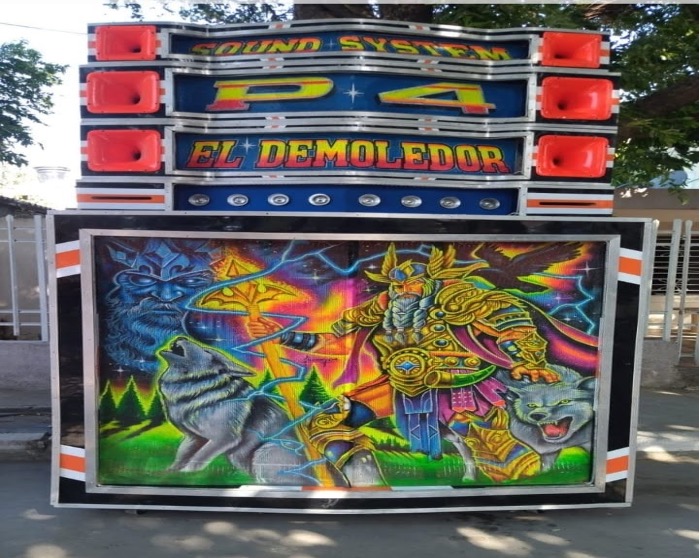
Turbo-style Picó, P-4 El Demoledor, from Santa Marta. Source: Jorge Acosta
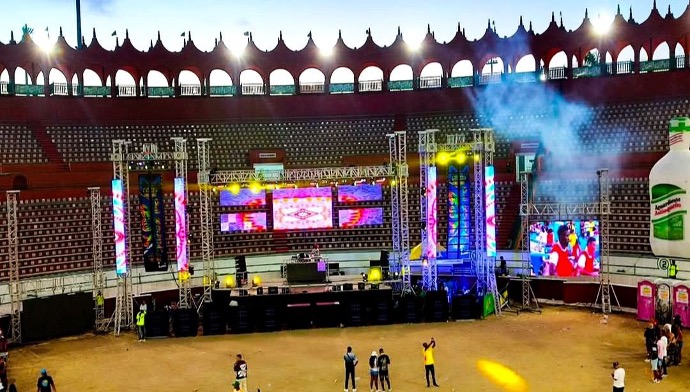
Fraccionado-style Picó, El Rey de Rocha, Cartagena. Source: @YankySabor
How Has the Idea of El Picó as Cultural Heritage Emerged?
Over time, el picó has become a totem of the popular culture in the Colombian Caribbean, representing creativity, energy, and vibrancy in festive gatherings such as casetas, verbenas, and neighbourhood tómbolas [1]. However, its rise has also led to strong social stigmatisation, with picó parties in working class neighbourhoods often demonised as spaces associated with violence, drugs, and the so-called “plebeian” crowd, in a way that can be described as aporophobic.
This has resulted in the devaluation of el picó and its surrounding cultural context, negatively impacting the local economy that has developed around it. Those affected include picó owners and their family-run businesses, as well as event organisers, DJs, painters, and technicians associated to these sound systems. Additionally, many jobs linked to popular festivities—such as street vendors selling food and drinks, ticket sellers, and others involved in managing events—have also suffered. This is largely because local authorities frequently impose restrictions or outright bans on picó parties at various times of the year, sometimes using noise pollution as a pretext to limit their dissemination. [2]
Faced with this situation, picó owners and event organisers have begun forming trade associations, advocating for their right to work and to preserve traditional festive practices with cultural and historical significance. One of the key strategies in this effort has been the patrimonialisation of el picó and its festive environment.
Santa Marta was the first city to initiate this patrimonialisation process. Jorge Acosta, president of the Asociación de Picoteros de Santa Marta (ASOPIMARTA), explains:
“We succeeded in including the picó in the updated inventory of the district’s cultural heritage, recognising its tradition. The process began in 2012, and by 2016, the picó had been officially registered as heritage. The Faculty of Anthropology at the University of Magdalena supported this initiative. During the administration of Dr Carlos Caicedo as mayor, it was included it in his government plan.” (Interview, February 2025)
While this recognition has made it easier for casetas and other picó-led celebrations to be part of Santa Marta’s official festive calendar, Acosta notes that challenges remain. There are still instances where public officials and police officers disregard the heritage designation, imposing restrictions and shutting down events. As a result, securing el picó as a recognised cultural asset remains a long-term effort.
Similarly, in Barranquilla, there have been ongoing efforts to include el picó in the city’s official heritage inventory. Carlos Miranda, president of the Asociación de Bailes de Barranquilla (ASOBAILES), describes the process:
“In 2015, a group of friends, including Laín Domínguez, took the initiative to have picós and verbenas declared heritage. We formed an alliance between ASOBAILES and WorldPicó to work towards this recognition. The Secretariat of Culture invited us to participate in working groups specifically aimed at achieving the declaration of picotera culture as heritage.
We began the process together with the Secretariat, initially presenting the proposal at the district level. However, in its first review, the District Council of Culture rejected it, arguing that picotera culture lacked a distinct identity in Barranquilla. The proposal was shelved. At that point, Laín and I decided to reassess everything, conducting further research and compiling evidence—photographs, historical records, and other documentation. We formally petitioned for the process to be reopened. Under the leadership of Juan José Jaramillo, the Secretariat of Culture resumed the process in 2017. However, progress has been painfully slow due to strong opposition from various sectors, leaving the initiative largely stagnant.” (Interview, February 2025)
The WorldPicó Foundation, mentioned by Carlos Miranda, is the Fundación Cultural y Melómana Distrital de Barranquilla, established in 2015 under the presidency of Laín Domínguez. It was created specifically to consolidate the heritage declaration for el picó:
“WorldPicó was established as a collective effort bringing together picó owners, technicians, painters, collectors, and all those involved in picotera culture, with the goal of securing its recognition as cultural heritage.” (Laín Domínguez, Interview, February 2025)
As Miranda highlights, the patrimonialisation initiative aims to encompass both el picó itself and its broader festive context, the verbena.
One key difference between Santa Marta and Barranquilla lies in their approaches to picó heritage. In Barranquilla, el picó is closely tied to verbenas—popular celebrations with deep historical and social connections to the city’s carnival. As a result, efforts to secure el picó as cultural heritage are often linked to this festive tradition. In contrast, while el picó is an important part of Santa Marta’s carnival, its patrimonialization has been framed more broadly, without being explicitly tied to the carnival context, as is the case in Barranquilla.
The Relationship Between the Heritage of the Barranquilla Carnival and el Picó
The prominence of the Barranquilla Carnival in shaping the city’s heritage discourse around el picó raises an important question: is there a connection or influence between the successful heritagization of the Carnival and the ongoing efforts to recognise el picó as cultural heritage?
The answer involves two key aspects: on one side, there is an indirect relationship between the Barranquilla Carnival as heritage and popular festivities such as verbenas. On the other hand, the Carnival is seen as a a negative influence—or a poor example to follow—in the process of declaring the picó as cultural heritage. I will begin with the indirect relationship.
It is essential to remember that the Barranquilla Carnival has received two heritage recognitions: in 2001, it was declared Cultural Heritage of the Nation by the Colombian Congress, and in 2003, UNESCO recognized it as a Masterpiece of the Oral and Intangible Heritage of Humanity.
As part of the strategy to safeguard the heritage of the Carnival and other cultural assets at the national level, a Special Safeguarding Plan was created. For the Carnival, this plan was formalized in 2015 by the Ministry of Culture (now the Ministry of Cultures, Arts, and Knowledges).
This plan identifies and analyses the cultural manifestations of the Carnival, its history, and the crucial role of cultural managers who keep this festive tradition alive. It also defines the responsibilities of public entities in supporting and preserving the Carnival, where the Fundación Carnaval de Barranquilla plays a significant role. Additionally, it outlines projects and strategic actions to organize and manage both the economic and thematic aspects of the safeguarding process.
Within the Special Safeguarding Plan, the importance of popular neighborhood festivities and verbenas is highlighted as one of the central elements of the Barranquilla Carnival. A specific strategic action is defined to promote dances in the neighborhoods, recognizing them as fundamental spaces for the celebration and preservation of the Carnival tradition.
This is where the patrimonialization process of the Barranquilla Carnival indirectly connects with the picó, as the picó has a long-standing presence in verbenas barriales and Carnival celebrations. A socio-cultural symbiosis developed between the picó—as a sound system—and the Carnival festivity, which took shape in Barranquilla from the 1960s onwards.
For this reason, the picotero movement in Barranquilla strongly associates the picó with the verbena, without disregarding its presence in other popular events such as casetas, community tómbolas, neighborhood concerts, and even social gatherings in estaderos and family parties.
An illustrative example of this connection is the ASOBAILES association, which in 2023 launched a slogan where the picó symbolically represents both the Carnival and the verbena, forming a sort of synecdochic image:

“The Carnival is Verbena”, accompanied by an image of a picó. (ASOBAILES, 2023)
Regarding the negative influence of the Barranquilla Carnival’s heritage process on the picó, Nicolás Contreras—a picotero with an academic background—clearly illustrates what could serve as a poor example of heritage recognition:
“This was a bitter lesson [the heritage process of the Barranquilla Carnival]. They carried out the intellectual process [the research needed to declare the Carnival as heritage], and I mention leading figures such as Dolcey Romero Jaramillo, Martín Orozco Cantillo, Professor Colpas—basically, the entire elite of the Social Sciences Department at the Universidad del Atlántico, including Alfonso Múnera. These people did the groundwork, and then the Char family arrived with a man named León Caridi, founded the Fundación Carnaval de Barranquilla, and privatized the Carnival. They took it away from us.” (Nicolás Contreras, interview, February 2025) [Author’s note: added clarifications in brackets].
Here, Contreras exposes how what began as a commendable social research process to declare the Carnival as heritage and provide the necessary justification ultimately ended up in the hands of a select few—specifically, politicians (the Char family)—causing a process of accelerated privatization, where access to the cultural asset becomes part of market logic.
This aligns with the conclusions of anthropologist Mauricio Pardo’s study “El patrimonio como una forma de culturización” (2019), which highlights a discrepancy between the social principles of cultural heritage and its actual management. While material and intangible goods are declared heritage for the sake of collective interest, in practice, they come under bureaucratic control by the State, multilateral entities, or private actors, turning them into commodities rather than community-driven assets.
The privatization of the Barranquilla Carnival has led to various economic and social issues. For instance, large-scale mass spectacles—such as parades and concerts—have been prioritized, while neighborhood events like verbenas and casetas have been relegated, contradicting the very guidelines of the Special Safeguarding Plan, which explicitly states that verbenas should be promoted by public policy.
This is why Nicolás Contreras’ insights are so relevant. As a social researcher, he has been conducting fieldwork for the heritage declaration of the picó in Santa Marta, Barranquilla, and Cartagena. From his perspective, what happened with the Barranquilla Carnival serves as a lesson to be learned and overcome in the heritage recognition process of the picó.
“Las Tres Perlas” Project
“Las Tres Perlas” (‘The Three Pearls’) is an initiative seeking to declare the picó as a cultural asset across the three cities of Santa Marta, Barranquilla, and Cartagena before the Ministry of Cultures, Arts, and Knowledge.
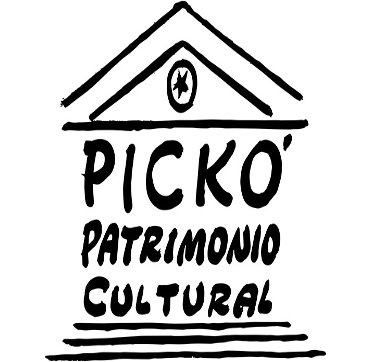
This recent process is the result of the efforts of associations of picó owners and promoters of grassroots dances in the three cities. It is also the product of their engagement with academics and researchers who have fostered a participatory and creative approach to the patrimonialization of the picó.
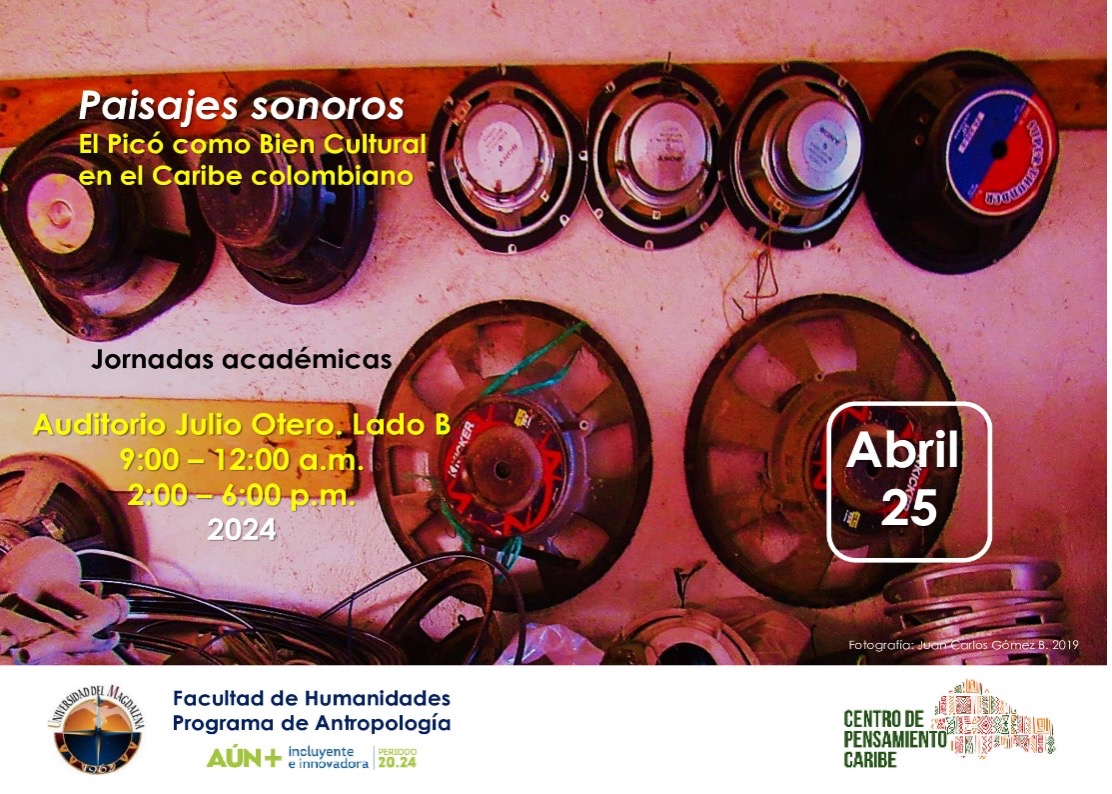
Flyer for Soundscapes. The Picó as a Cultural Asset in the Colombian Caribbean, Santa Marta 2024.
One of the most significant events in this process was the discussion forum “Soundscapes: The Picó as a Cultural Asset in the Colombian Caribbean”, organised by the University of Magdalena in Santa Marta in April 2024, in which I participated as a speaker. This event established a strong bridge of participation and collaboration among enthusiasts of picó culture—music lovers, academics, researchers, picoteros and picoteras, sound system owners, dance organisers, journalists, musicians, and others chosen by the “universal neighbourhood” (Rubén Blades)—to begin constructing projects based on shared interests in support of the picó.
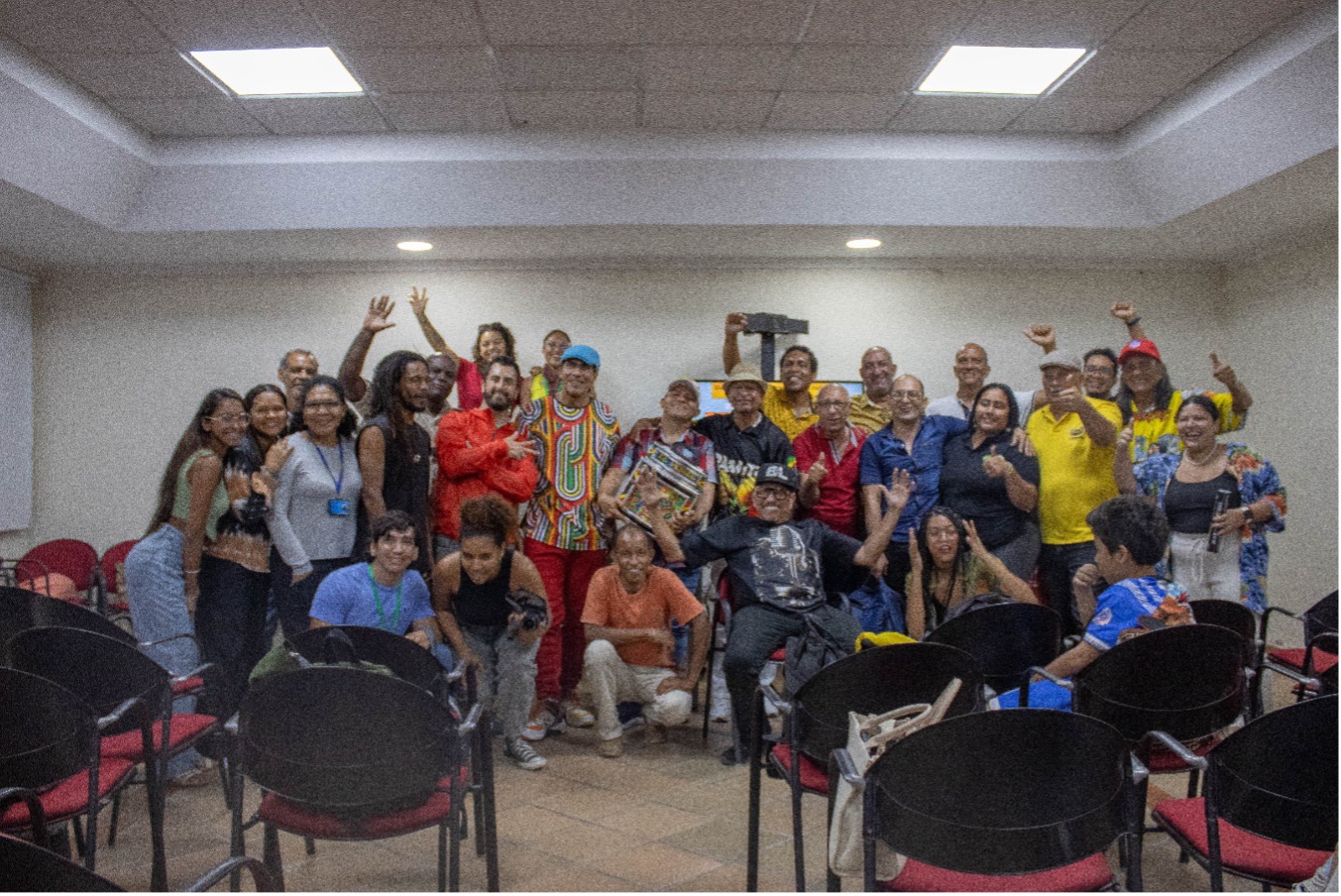
Participants of the roundtable “Soundscapes,” April 2024, Santa Marta. Source: Juan Carlos Gómez.
Following this event and direct meetings between picó owners’ associations and dance organisers with Minister Juan David Correa from the Ministry of Cultures, the Las Tres Perlas project was formally established. Through further meetings and planning workshops, Santa Marta, Barranquilla, and Cartagena were defined as the primary cities for this recognition. Additionally, it was determined that the heritage status should be limited to the turbo, primarily due to its historical significance and its unique pictographic characteristics.

Alex Aleman recostado en uno de los bafles del picó turbo El Timbalero, Barranquilla. Fuente: Alex Aleman
Jorge Acosta, president of ASOPIMARTA, clarifies that although inclusion in Santa Marta’s cultural assets has greatly benefited the local picotero community, securing national heritage recognition through the Ministry of Cultures would further strengthen the process and allow them to connect directly with public policy. This, in turn, would ensure the development of a dedicated Special Safeguarding Plan (Plan Especial de Salvaguarda) at the regional level.
Carlos Miranda of ASOBAILES in Barranquilla similarly asserts that, regardless of the Las Tres Perlas project, ASOBAILES will continue to pursue official recognition of the picó and verbena as part of the city’s heritage assets at the district level.
In Cartagena, Las Tres Perlas is supported by the picó owners’ association ASOPIKAR (Asociación de Picoteros de Cartagena), with José Miguel Padilla playing a key role. Padilla personally compares the patrimonialisation of the picó to caring for a child:
“As a picotero, you must love your picó like a child—cherish it, care for it. You see, the music of the picó is like the blood pumping through the heart—without it, there is no life. That is why you must nurture the picó well, just as you would a small child.” (José Miguel Padilla, interview, February 2025).
Meanwhile, in Cartagena, cultural managers, musicians, and researchers from the Roztro Foundation have been developing the Special Safeguarding Plan for the recognition of champeta music as heritage. Within this framework, they have included the picó as a cultural manifestation, considering it, in a maternal sense, as a ‘child’ of champeta due to its role in the dissemination and production of this genre within the enramadas of the Colombian Caribbean. This initiative thus complements the Las Tres Perlas project.
To provide an overview of the individuals directly or indirectly involved in the Las Tres Perlas project, Nicolás Contreras, as the lead researcher, has conducted an inventory as part of his ongoing participatory action research (IAP) in the prefeasibility stage. In addition to those already mentioned in this blog, the following people have contributed to the process:
- From the Universidad del Magdalena: Researchers Juan Carlos Gómez and Roberto Almanza.
- Researchers, knowledge holders, and cultural managers: Sídney Reyes, Walter Hernández (Índigo), Sadid Ortega Pérez, Nelson García, Laín Domínguez, Dairo Barriosnuevos, Carlos Miranda, Jorge Acosta, and Jorge Giraldo (myself).
- Picó owners and picoteros: William Safari, Octavio Miguel Pupo, Alí Zarache, and Ana Pérez.
- Radio presenter: Ralphy Polo.
- Other organisations involved: ASODISMAC (Asociación de Disfraces y Manifestaciones del Carnaval) in Barranquilla, Fundación Cultural Afroamericana (FUKAFRA), and Safari Musical, a WhatsApp group dedicated to thematic discussions.
- External researcher: Jacob Sunshine (Memphis, United States).
It is often assumed that Las Tres Perlas primarily concerns picó owners, yet not all are formally associated with an organisation. For example, in Santa Marta, ASOPIMARTA includes 50 registered members, while approximately 100 active picós continue to participate in the city’s festive scene without being officially enrolled in the association.
This represents a challenge to be addressed: consolidating and strengthening the organisational networks of picó owners and dance organisers in the face of the regional picó patrimonialisation process. The ultimate goal is to establish a cultural policy for festive traditions, managed by cultural practitioners themselves—free from political monopolisation and external privatisation interests.
Notes
[1] The most well-known spaces for picó culture in the Colombian Caribbean are casetas (K-z) and verbenas, the latter emerging in Barranquilla and primarily linked to carnival celebrations. Both are neighborhood parties where one or two streets are closed off for local residents and attendees who pay an entry fee. Abandoned lots or football fields are also commonly used. Other venues include estaderos (indoor establishments dedicated to enjoying music) and even large-scale concerts, where the event reaches a much greater scale than in the traditional spaces.
[2] See for example https://www.rcnradio.com/colombia/propuesta-para-que-la-policia-pueda-decomisar-pico-en-cartagena-fue-estudiada-por.
References
Pardo, Mauricio. “El patrimonio como una forma de culturización.” Plural. Antropologías desde América Latina y del Caribe 3, pp. 107-135, 2019.
About the Author:
Jorge Enrique Giraldo Barbosa is a Caribbean anthropologist and music lover, deeply connected to the picotera culture. His work is oriented towards the anthropology of music and collaboration with Indigenous peoples, mainly from the Sierra Nevada de Santa Marta and the department of La Guajira, Colombia.
